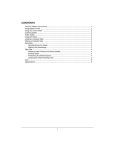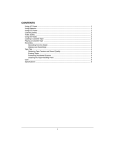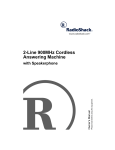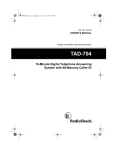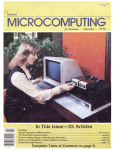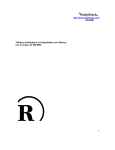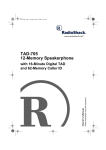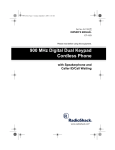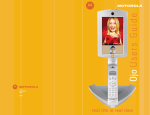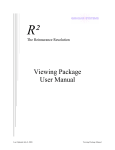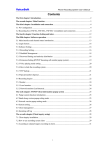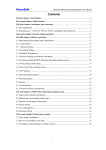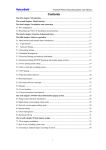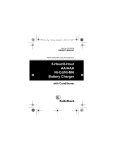Download Sprint Nextel SP7084 User's Manual
Transcript
Please read before using this equipment. 43-5708.fm Page 1 Monday, September 18, 2000 7:56 AM SP708 4-Line Phone System Owner’s Manual 43-5708.fm Page 2 Monday, September 18, 2000 7:56 AM ˆ Contents Features .................................................................................................................................. 5 Read This Before Installation ............................................................................................... 6 A Quick Look at Your Phone ................................................................................................. 9 Installation ............................................................................................................................ Planning Your System ........................................................................................................ System Communication ..................................................................................................... Square Configuration ..................................................................................................... Non-Square Configuration — Private Line Support ....................................................... Mounting the System ......................................................................................................... On a Desk ...................................................................................................................... On a Wall or Wall Plate .................................................................................................. Installing the Backup Batteries ........................................................................................... Battery Power Levels ..................................................................................................... Connecting the AC Adapter ............................................................................................... Attaching the Handset ........................................................................................................ Connecting a Fax or PC Modem ........................................................................................ 10 10 10 10 10 11 11 12 13 13 13 13 14 Preparation ........................................................................................................................... 15 Setting up the Stations ....................................................................................................... 15 Verifying the Station and Line Configurations .................................................................... 15 Verifying System Configuration .......................................................................................... 16 Station Reset ..................................................................................................................... 16 Changing or Updating a Station Extension Number .......................................................... 16 Setting the Private Line ...................................................................................................... 16 Setting the Ringer .............................................................................................................. 16 Setting the Ringer Volume ............................................................................................. 17 Setting Always Ring ....................................................................................................... 17 Setting the Handset, Headset and Speaker Volume .......................................................... 17 Handset/Headset Volume .............................................................................................. 17 Speakerphone Volume .................................................................................................. 17 Telephone Operation ............................................................................................................ 18 Using a Headset ................................................................................................................ 18 Switching Between the Headset and Speakerphone .................................................... 18 Making Calls ...................................................................................................................... 18 Selecting a Line ............................................................................................................. 18 Making a Conference Call ............................................................................................. 18 Conference Calling with Two Outside Lines .................................................................. 19 Answering Calls ................................................................................................................. 19 Answering a Call While You Are On Another Line ......................................................... 19 Transferring Calls ............................................................................................................... 19 Without Announcement ................................................................................................. 19 RadioShack and RadioShack.com are trademarks used by RadioShack Corporation. The Sprint Logo is a registered trademark of Sprint Communications Company L.P. Used under license. 2 Contents 43-5708.fm Page 3 Monday, September 18, 2000 7:56 AM With Announcement ...................................................................................................... Using Auto Redial .............................................................................................................. Using Flash ....................................................................................................................... Using Hold ......................................................................................................................... Using Mute ........................................................................................................................ Using the Intercom ............................................................................................................ Using Automatic Answer ............................................................................................... Paging All Stations ........................................................................................................ Monitoring Other Rooms ............................................................................................... Using Standard Phones with the System .......................................................................... 20 20 20 20 21 21 22 22 22 22 Memory Operation ............................................................................................................... Storing a Name and Number in Memory ........................................................................... Entering a Pause .......................................................................................................... Editing Stored Numbers ................................................................................................ Deleting Stored Numbers .............................................................................................. Dialing a Stored Number ................................................................................................... Chain-Dialing Service Numbers .................................................................................... Testing Stored Emergency Numbers ............................................................................ 23 23 23 23 24 24 24 24 Caller ID Operation .............................................................................................................. Programming Caller ID ...................................................................................................... Reviewing Caller ID Records ............................................................................................ Caller ID Messages ....................................................................................................... Dialing Numbers From a Caller ID Record ........................................................................ Storing a Caller ID Record in Memory ............................................................................... Deleting Records ............................................................................................................... Caller ID Operation with Auto Attendant On ...................................................................... 25 25 26 26 26 27 27 27 Auto Attendant Operation ................................................................................................... Assigning an Auto Attendant Station ................................................................................. Turning off Auto Attendant ................................................................................................. Auto Attendant Station Operation ...................................................................................... 28 28 29 29 TAD Operation ...................................................................................................................... Recording Greetings ......................................................................................................... Reviewing the Greetings ............................................................................................... Setting the Greeting Mode ................................................................................................ Selecting the Primary Greeting ......................................................................................... Selecting the Number of Rings .......................................................................................... Call Screening ................................................................................................................... Setting the TAD to Answer Calls ....................................................................................... Setting the Greeting Timer ............................................................................................ Recording Incoming Messages ......................................................................................... Recording a Memo ............................................................................................................ Recording a Conversation ................................................................................................. Playing Messages ............................................................................................................. Playing New Messages ................................................................................................. Playing All Messages .................................................................................................... Repeating Messages .................................................................................................... 30 30 30 31 31 32 32 32 32 33 33 34 34 34 34 34 Contents 3 43-5708.fm Page 4 Monday, September 18, 2000 7:56 AM Skipping to the Next Message ....................................................................................... Pausing Message Playback .......................................................................................... Variable Speed Playback ............................................................................................... Deleting Messages ............................................................................................................ Remote Operation .............................................................................................................. Programming a Remote Access Code .......................................................................... Using Remote Access ................................................................................................... 34 34 35 35 35 35 35 Troubleshooting ................................................................................................................... Performing a System Update ............................................................................................. Resetting the Time and Date ............................................................................................. Care ................................................................................................................................... 36 38 38 39 WARNING: To reduce the risk of fire or shock hazard, do not expose this product to rain or moisture. CAUTION RISK OF ELECTRIC SHOCK. DO NOT OPEN. ! CAUTION: TO REDUCE THE RISK OF ELECTRIC SHOCK, DO NOT REMOVE COVER OR BACK. NO USER-SERVICEABLE PARTS INSIDE. REFER SERVICING TO QUALIFIED PERSONNEL. This symbol is intended to alert you to the presence of uninsulated dangerous voltage within the product’s enclosure that might be of sufficient magnitude to constitute a risk of electric shock. Do not open the product’s case. ! 4 This symbol is intended to inform you that important operating and maintenance instructions are included in the literature accompanying this product. Contents 43-5708.fm Page 5 Monday, September 18, 2000 7:56 AM ˆ Features Your Sprint 4-Line Phone System combines advanced telephone technology with a complete four-line telephone system. You can connect up to twelve stations, with each serving as an extension on which you can make and receive outside as well as internal calls. Programmable Remote Access Code — lets you set a three-digit remote access code for secure remote operation. The phone’s other features include: Toll-Saver — lets you avoid unnecessary charges when you call by long distance to check your messages. Caller ID Memory — stores and displays up to 140 incoming call records (incoming phone numbers and names). Auto Attendant System — sets one station as Auto Attendant so every call is first received by that station. Intercom with Paging — lets you call individual stations, or page all stations at the same time. Digital Speakerphone — allows clear handsfree conversations. Call Screening — lets you listen as a caller leaves a message so you can decide whether or not to answer the call. Variable Speech Control — allows you to change the speed of message playback without affecting the tonal quality. Your local telephone company might offer a special telephone service called Rollover or Hunt. This service allows incoming calls to a line in use to automatically switch to the next available telephone line. Contact your local telephone company for more information regarding this service. The phone comes with the following items: Call Routing — lets you route callers to any extension. Headset Jack — lets you attach a headset (not supplied) for hands-free convenience. • telephone base • handset • coiled handset cord Hearing Aid Compatibility — lets you use your phone with hearing aids that have a T (telephone) switch. • two long RJ14 modular cords and two short RJ14 modular cords • AC adapter TAD (Telephone Answering Device) Features • mounting bracket (attached to the telephone’s base) Timed Answering — lets you set two outgoing messages to answer calls during a specified time of a day. • spare autodial station card • Multiple Answering Messages — lets you make up to six messages for the caller to hear. 3 /32-inch (2.5 mm) headset jack adapter (sub-mini to modular type plug converter) • extension card Features 5 43-5708.fm Page 6 Monday, September 18, 2000 7:56 AM READ THIS BEFORE INSTALLATION THE FCC WANTS YOU TO KNOW We have designed your system to conform to federal regulations, and you can connect it to most telephone lines. However, each telephone (and each device, such as an answering machine) that you connect to the telephone line draws power from the telephone line. We refer to this power draw as the device's ringer equivalence number, or REN. The REN is on the bottom of your system. In the unlikely event that your telephone causes problems on the telephone line, the telephone company can disconnect your service. The telephone company attempts to notify you in advance. If advance notice is not practical, the telephone company notifies you as soon as possible and advises you of your right to file a complaint with the FCC. If you use more than one telephone or other device on the line, add up all of the RENs. If the total is more than five, your telephones might not ring. In rural areas, a total REN of three might impair ringer operation. If ringer operation is impaired, remove a device from the line. Warning: To prevent fire or shock hazard, do not expose this product to rain or moisture. FCC STATEMENT Also, the telephone company can make change to its lines, equipment, operations, or procedures that could affect the operation of this telephone. The telephone company notifies you of these changes in advance, so that you can take the necessary steps to prevent interruption of your telephone service. This equipment is capable of providing users access to interstate providers of operator services through the use of access codes. Modification of this equipment by call aggregators to block access dialing codes is a violation of the Telephone Operator Consumers Act of 1990. Your system complies with Part 68 of FCC Rules. You must, upon request, provide the FCC (Federal Communication Commission) registration number and the REN to your telephone company. These numbers are located on the bottom of the telephone's base. Your phone might cause TV or radio interference even when it is operating properly. To determine whether your phone is causing the interference, turn off your phone. If the interference goes away, your phone is causing it. Try to eliminate the interference by: Note: You must not connect your telephone to: • moving your phone away from the receiver • connecting your phone to an AC outlet that is on a different electrical circuit from the receiver • coin-operated systems • party-line systems • contacting your local RadioShack store for help • most electronic key telephone systems If you cannot eliminate the interference, the FCC requires that you stop using your phone. 6 Features 43-5708.fm Page 7 Monday, September 18, 2000 7:56 AM LIGHTNING cleaners or aerosol cleaners. Use a damp cloth for cleaning. Your telephone has built-in protection circuits to reduce the risk of damage from surges in telephone and power line current. These protection circuits meet or exceed the FCC requirements. However, lightning striking the telephone or power lines can damage your telephone. Lightning damage is not common. Nevertheless, if you live in an area that has frequent electrical storms, we suggest that you unplug your telephone when storms approach to reduce the possibility of damage. IMPORTANT SAFETY INSTRUCTIONS When using your telephone equipment, basic safety precautions should always be followed to reduce the risk of fire, electric shock, and injury, including the following: 1. Read and understand all instructions. 2. Follow all warnings and instructions marked on the product. 3. Never install telephone wiring during a lightning storm. 4. Never install telephone jacks in wet locations unless the jack is specifically designed for wet locations. 5. Never touch uninsulated telephone wires or terminals unless the telephone line has been disconnected at the network interface. 6. Use caution when installing or modifying telephone lines. 7. Do not fix the AC power supply cord to building surfaces with metal fittings. 9. Do not use the telephone near water, for example, near a bath tub, wash bowl, kitchen sink, or laundry tub, in a wet basement, or near a swimming pool. 10. Do not place the telephone on an unstable cart, stand, or table. The telephone may fall, causing serious damage to the product. 11. Slots and openings in the cabinet and the back or bottom are provided for ventilation. To protect it from overheating, these openings must not be blocked or covered. The openings should never be blocked by placing the product on a bed, sofa, rug, or other similar surface. This telephone should never be placed near or over a radiator or heat register. This telephone should not be placed in a built-in installation unless proper ventilation is provided. 12. This telephone should be operated only from the type of power source indicated on the marking label. If you are not sure of the type of power supply to your home, consult your local power company. 13. Do not allow anything to rest on the power cord. Do not locate the telephone where the cord will be stepped on. 14. Do not overload wall outlets and extension cords as this can result in a risk of fire or electric shock. 15. Never push objects of any kind into this product through cabinet slots as they may touch dangerous voltage points or short out parts that could result in a risk of fire or electric shock. Never spill liquid of any kind on the product. 8. Unplug the telephone from the wall outlet before cleaning. Do not use liquid Features 7 43-5708.fm Page 8 Monday, September 18, 2000 7:56 AM 16. To reduce the risk of electric shock, do not disassemble the telephone. Take it to a qualified serviceman when service or repair work is required. Opening or removing covers may expose you to dangerous voltages or other risks. Incorrect reassembly can cause electric shock when the telephone is subsequently used. 17. Unplug the telephone from the wall outlet and refer servicing to qualified services personnel under the following conditions: • When the power cord plug is damaged or frayed. • If liquid has been spilled into the product. • If the product has been exposed to rain or water. • If the telephone does not operate normally by following the operating instructions. Adjust only those controls that are covered by the operating instructions because improper adjustments of other controls may result in damage and will often require extensive work by a qualified technician to restore the product to normal operation. • If the product has been dropped or the cabinet has been damaged. • If the product exhibits a distinct change in performance. 18. Avoid using a telephone (other than a cordless type) during an electrical storm. There may be a remote risk of electric shock from lightning. 19. Do not use the telephone to report a gas leak while in the vicinity of the leak. SAVE THESE INSTRUCTIONS 8 Features 43-5708.fm Page 9 Monday, September 18, 2000 7:56 AM ˆ A Quick Look at Your Phone Use these buttons to select options that appear on the screen by pressing the button below the desired option. Indicator lights when Auto Attendant is on, see Page 28. SCREEN/DO NOT DISTURB — press to stop incoming calls and pages. To resume taking calls and pages, press again. SCRATCH PAD — press once while the phone is on- or off-hook. Enter a number you want to store, then press again. The phone beeps once. To dial the stored number later, lift the handset and press SCRATCH PAD. When the number appears on the screen, press DIAL. MEMORY DIAL — while on-hook, enter a number you want to store, then press once. Press again to view the number. To dial a stored number, lift the handset and press MEMORY DIAL once. REDIAL — press to redial the last phone number you called. A Quick Look at Your Phone SPEAKER — press once to use speakerphone, twice to hang up. Talk clearly in the direction of the phone. To switch to the handset, lift the handset. To switch back, press SPEAKER again. 9 43-5708.fm Page 10 Monday, September 18, 2000 7:56 AM ˆ Installation Installing your phone is easy, but it is important that you follow the instructions in the sequence that they appear in this manual for the telephone to work properly. PLANNING YOUR SYSTEM To take full advantage of many of the system’s features, you must have four telephone lines with separate phone numbers. However, you can choose to connect the system to only one, two, or three telephone lines. You can connect the system to two-line modular telephone line jacks, or you can connect it to single-line jacks. If you use single line jacks, you must also use an optional two-line coupler available at your local RadioShack store. Notes: • Your system is for tone lines only. If your telephone service is pulse type, check with your telephone company about changing to tone service. • Your system connects directly to a modular telephone line jack. If your telephone wiring does not have a modular jack, you can update it yourself using jacks and adapters available at your local RadioShack store, or have the telephone company update the wiring for you. • The line that connects the telephone jacks to the telephone company's wiring must be twisted-pair cable. Otherwise, you might experience interference (crosstalk) between telephone lines. • The USOC number of the two-line jack to be installed is RJ14C (or RJ14W for a wall plate jack). The USOC number of 10 the single-line jack to be installed is RJ11C (or RJ11W for a wall plate). Before actually starting the connections, plan your system accordingly. 1. Identify the number of stations you need (maximum is 12). 2. Determine which outside lines connect to which stations (maximum 4 per station). 3. Decide which stations require a private line (see “Setting the Private Line” on Page 16). SYSTEM COMMUNICATION The system uses Line 1 to transmit information such as system and line use status, as well as up to two simultaneous intercom conversations. Lines 1 and 2 must be common to all stations. Lines 3 and 4 can be common to all or some of the stations. Note: If Line 1 is disconnected, you can still make and receive phone calls on the other lines, but the phones will not work as a system. Square Configuration When all lines are all common, the configuration is called square. Since all lines are common, calls on any line can be transferred to any station. Non-Square Configuration — Private Line Support When all lines are not common, the configuration is called non-square. Depending on Installation 43-5708.fm Page 11 Monday, September 18, 2000 7:56 AM which line is connected to which station, you can transfer calls on some lines to some stations. The following chart shows a sample nonsquare configuration. In this configuration, lines 1 and 2 are common to all stations, and lines 3 and 4 are available to groups of stations. Station 11 is the Auto Attendant. Since all lines are available at the Auto Attendant station, the Auto Attendant can answer all lines. Calls to Lines 1 and 2 can be transferred to all stations. Calls on Line 3 can be transferred to all stations except stations 14 and 15. Calls on Line 4 can only be transferred to the stations that have Line 4 (stations 11, 16, and 17 in the sample below). If you want to build a non-square configuration, we suggest you make a planning chart similar to the one shown for easier connection. Station ID MOUNTING THE SYSTEM You can place your phone on a desk, or mount it on a standard wall plate or directly on a wall. Select a location that is near a modular telephone line jack and an AC outlet. On a Desk 1. Remove the mounting bracket by pulling it down. 2. Plug one end of one of the supplied 2line modular telephone line cords into LINE 1&2 on the bottom of the telephone. Telephone Cord AC Adapter Cord Line Number 1 2 3 4 Station 11 (Auto Attendant) X X X X Station 12 X X X Station 13 X X X Station 14 X X Station 15 X X Station 16 X X X X Station 17 X X X X Station 18 X X X Station 19 X X X Station 20 X X X Station 21 X X X Station 22 X X X 3. Route the cord through the groove on the bottom of the phone, then plug the other end of the cord into a two-line phone jack or a coupler that is connected to two single-line phone jacks. 4. Plug the other cord into LINE 3&4 on the bottom of the telephone, use a coin to route the cord through the groove, and plug the other end into the other two-line jack or coupler. 5. Leave the bracket detached and connect the AC adapter (see “Connecting the AC Adapter” on Page 13) and install the backup batteries (see “Installing the Backup Batteries” on Page 13). Note: See “Setting the Private Line” on Page 16 to effectively use the private line(s). 6. Attach the bracket with the narrow end of the wedge pointing down into the top Installation 11 43-5708.fm Page 12 Monday, September 18, 2000 7:56 AM four wall mount ports and push up to lock in place. 1. Drill two holes 315/16 inches apart. Thread two screws into the wall, letting the heads extend about 1/8 inch. 1/8 315/16 1/8 2. Follow Steps 1–5 of “On a Desk.” 3. Turn the mounting bracket upside down, then insert the bracket into the bottom slots with the narrow end of the wedge pointing upward. Push the bracket up to lock into place. On a Wall or Wall Plate 1. Follow Steps 1–5 of “On a Desk.” 2. Turn the mounting bracket upside down, then insert the bracket into the bottom slots with the narrow end of the wedge pointing upward. Push the bracket up to lock into place. 4. Align the keyhole slots on the telephone with the screws, then slide the telephone downward to secure it. 3. Align the bracket’s keyhole slots with the wall plate studs, then slide the base downward to secure it. Note: To mount the telephone directly on a wall, you need two screws (not supplied) with heads that fit into the keyhole slots on the bottom of the base. Follow these steps for placement on a wall. 12 Installation 43-5708.fm Page 13 Monday, September 18, 2000 7:56 AM INSTALLING THE BACKUP BATTERIES Battery Power Levels Your system requires four AA batteries to provide backup power for a few hours if AC power fails. The backup batteries do not power all the system's features. For the best performance and longest life, we recommend RadioShack alkaline batteries. If the power fails but the backup batteries are installed and have power, all data and system information is retained and network communication is restored. When the batteries have enough power (over 5.6V), no icons appear. When the batteries become weak (5 to 5.6V), appears. When the batteries are too weak (less than 5V) or not installed, appears. CONNECTING THE AC ADAPTER Cautions: Cautions: The supplied AC adapter supplies at least 11 volts AC and delivers at least 600 mA. Using an adapter that does not meet these specifications could damage the telephone or the adapter. ! • Use only fresh batteries of the required size and recommended type. • Before replacing the batteries, disconnect all telephone lines from your system. • Do not use rechargeable batteries. 1. Turn the unit over, press the tab on the battery compartment cover, then lift off the cover. 2. Place the batteries in the compartment over the ribbon as indicated by the polarity symbols (+ and –) marked inside. 3. Replace the cover. Warning: Dispose of old batteries promptly and properly. Do not burn or bury them. Cautions: Always remove old or weak batteries. Batteries can leak chemicals that can destroy electronic parts. Note: If the power is out and your phone is operating on battery power, the phone will automatically switch to pulse dialing. If you phone line does not support pulse dialing, you will not be able to dial. • To prevent damage to the telephone or the adapter, plug the adapter into the telephone before plugging the adapter into an AC outlet. 1. Insert the AC adapter's barrel plug into the adapter jack on the bottom of the telephone. 2. Route the adapter's cord through the groove on the bottom of the phone, then plug the adapter into a standard AC outlet. ATTACHING THE HANDSET Plug one end of the supplied coiled cord into the jack on the telephone's handset. Plug the other end into the jack with the handset mark on the left side of the telephone's base. Note: Your local RadioShack store sells a variety of longer coiled handset cords which can be useful if your telephone is mounted on a wall. Installation 13 43-5708.fm Page 14 Monday, September 18, 2000 7:56 AM CONNECTING A FAX OR PC MODEM You can connect a fax or PC modem to the system's data port, which uses Line 2. When you use a fax or modem, the connection is protected and will not be interrupted by incoming or transferred calls. PC/FAX/ PHONE DOWNSTREAM 1. Connect the fax’s or the modem’s cord to the DOWN STREAM data port. 2. Set PC/FAX/PHONE to PC/FAX. The data port is always active, regardless of the PC/FAX/PHONE setting. Placing the switch in the PC/FAX position silences the ring, turns off the Line 2 status indicator, and prevents the TAD from answering calls on Line 2. 3. Set PC/FAX/PHONE on all the stations connected to Line 2 to PC/FAX (including the Auto Attendant station). When a call comes in on Line 2, only the fax or modem answers. 14 Installation 43-5708.fm Page 15 Monday, September 18, 2000 7:56 AM ˆ Preparation On initial power-up (after all connections are completed) each station displays INITIAL SETUP, prompting you to set the station ID, time and date. Important: In this manual, the word “select” means you must press the button below the desired option. SETTING UP THE STATIONS 1. At the INTIAL SETUP screen, select START. 2. Select NEXT. appears. SET STATION 11 9. Use the keypad to enter the month (01– 12) and day (01–31). If you make a mistake, select BACK to re-enter the correct date. 10. Select SAVE, then NEXT. The day setting menu appears. 11. Select CHANGE until the correct day of the week appears. Then select NEXT. INITIAL SETUP COMPLETE appears. 3. Repeatedly select CHANGE until the desired extension number (11—22) appears. If the number is already used for another station, an error beep sounds and nn NOT AVAIL appears (nn = the station number). Select CHANGE to select another number. 4. Select SAVE. appears. 8. Select CHANGE to toggle between AM and PM, then select NEXT. The date setting menu appears. STATION nn SET 5. Select NEXT. The time setting menu appears. 6. Use the keypad to enter the hour and minutes in two digits. Precede a singledigit hour or minute with 0 (01, 02, 03 and so on). If you make a mistake, select BACK to re-enter the correct time. 7. Select SAVE, then NEXT. The AM/PM selection menu appears. 12. Write the name or section for each extension on the supplied extension card and slide it into the slot on the bottom of the phone. Note: INPUT CORRECT DATA appears if you enter an invalid date or time. Check and correctly enter the data. VERIFYING THE STATION AND LINE CONFIGURATIONS 1. Select LINE 1. The line indicator lights green and the speakerphone indicator lights red. The station ID appears to indicate the station is in use. 2. Using another phone, dial the telephone number for Line 2. The line indicator for Line 2 flashes red. If the indicator does not flash, check for correct installation. 3. Repeat Step 2 for Lines 3 and 4. If the indicators for all the lines flash, you have successfully installed this station. Preparation 15 43-5708.fm Page 16 Monday, September 18, 2000 7:56 AM VERIFYING SYSTEM CONFIGURATION To verify that all stations are communicating, hold down PAGE ALL until PAGING and the station numbers for all connected stations appear. Be sure all the stations connected to Line 1 appear. If any station does not appear, make sure the lines to and from that station are connected and in the correct line jacks. STATION RESET If line conditions cause communication errors between stations, you might have to reset the station(s). To reset a station, insert the tip of a pen into RESET on the back of the phone. A click sounds and the display and station indicators briefly turn off, then back on. Caution: Pushing RESET erases all data and system information. CHANGING OR UPDATING A STATION EXTENSION NUMBER You set the extension number (11–22) when you initially set up the system (see “Setting up the Stations” on Page 15). If you must change the number, follow these steps. If the number is already used for another station, an error beep sounds and nn NOT AVAIL appears. Select CHANGE to select another number. 5. Select SAVE. 6. Press PROGRAM to exit. SETTING THE PRIVATE LINE You must connect Lines 1 and 2 to all the stations in the system for the intercom and paging features to work. However, when you create a non-square configuration (see “NonSquare Configuration — Private Line Support” on Page 10), you can make Lines 3 or 4 private lines, so your station (and the TAD) can answer the lines when the Auto Attendant feature is turned on. The private line is preset to OFF. 1. Press PROGRAM. 2. Select PHON, then select NEXT five times so PRIV LINE: OFF appears. 3. Select CHANGE, then ON/OFF to set the private line to ON. ON SELECT LN34 appears, and 34 flashes. 4. Use the number button to select the line that you do not want to be private. Your selection disappears. 5. Select SAVE. 6. Press PROGRAM to exit. 1. Press PROGRAM. 2. Select OTHER, then NEXT. SET STATION ID appears. Note: If you want to make a conference call, you must set PRIV LINE to OFF. 3. Select ENTER. SET STATION and the current extension number appear. SETTING THE RINGER 4. Repeatedly select CHANGE until the extension number desired (11–22) appears. Ringer settings are individually set at each station for each line. When the ringer is on, the line rings when calls are received. When the ringer is off, that line does not ring when a call is received. Whether the ringer is 16 Preparation 43-5708.fm Page 17 Monday, September 18, 2000 7:56 AM turned on or off, the line indicator flashes when a call is received. The phone is preset as ringer ON for all lines. To turn the ringer off for individual lines, follow these steps. However, you can set your station to Always Ring (even in these circumstances). Note: Even with Always Ring on, the station does not ring when you are talking on the speakerphone (outside line or intercom). 1. Press PROGRAM. 2. Select PHON, then select NEXT twice so the RINGER SELECT menu appears. 3. Select ENTER. LINE n RING: appears. line, or when the Auto Attendant feature is on. ON 4. Select CHANGE to toggle between turning the ringer ON or OFF for the selected line. 5. Select NEXT to advance to the next line selection. 6. Repeat Steps 4 and 5 until all lines are programmed. 7. Press PROGRAM to exit. Setting the Ringer Volume You can set the ringer volume to HI, LOW, or OFF, using RINGER VOL. OFF/LO/HI RING VOL. 1. Press PROGRAM. 2. Select PHON. 3. Select NEXT four times so ALWAYSRING appears. 4. Select CHANGE to toggle between ON and OFF. 5. Press PROGRAM to exit. SETTING THE HANDSET, HEADSET AND SPEAKER VOLUME You can individually set the volume levels for the handset, speaker, and headset. When you switch over, the volume level is automatically changed to the set level. Handset/Headset Volume While using the handset or headset, select – VOLUME + to adjust the volume. One to four bars appear to show the volume level. (1 bar is the lowest and 4 bars is the highest.) The volume setting remains at this level until you change it or a power failure occurs. When set to OFF, the phone does not ring when a call is received on any lines. Setting Always Ring Your system is designed so your phone does not ring when there is an incoming call on one line if you are already talking on another Speakerphone Volume When using the speakerphone or when the phone is not in use, select – VOLUME + to set the speakerphone volume. One to eight sets of bars appear to show the level. The volume setting remains at this level until you change it or a power failure occurs. Preparation 17 43-5708.fm Page 18 Monday, September 18, 2000 7:56 AM ˆ Telephone Operation Note: This owner's manual primarily explains the operation using the handset. You can also use a headset or the speakerphone. USING A HEADSET You can talk with hands-free convenience using an optional headset (not supplied) that has a modular type plug or 3/32-inch (2.5 mm) sub-mini plug. Contact your local RadioShack store for a suitable headset. If your headset has a modular plug, connect it directly to the modular jack with the headset mark on the left side of the base. To connect the headset with a sub-mini plug, first plug in the supplied headset jack adapter (sub-mini to modular converter) into the modular jack, then plug the headset into this headset jack adapter. Selecting a Line You can select the lines automatically or manually. When you lift the handset or press SPEAKER or HEADSET, you automatically get the first available line. The line indicator on your station lights green, and the indicator for the same line lights red at other stations. The priority of lines is set in numerical order. LINE 1 has priority over LINE 2, LINE 3 and LINE 4. If LINE 1 is in use, you get LINE 2 as you lift the handset. If LINE 1 and LINE 2 are in use, you get LINE 3. If two lines are ringing at the same time and you lift the handset, the same line priority applies. To manually select a desired line, lift the handset and press the desired LINE. Notes: Press HEADSET to answer or end a call. While the headset conversation is in progress, the headset indicator on the button lights red. • An error beep sounds when you select the line button of a call in use where privacy has not been released or when you select the button for a line that is not connected. Switching Between the Headset and Speakerphone • If all lines are in use, you hear an error beep and ALL LINES IN USE appears as you lift the handset. To switch from the speakerphone to the headset, press HEADSET. To switch from the headset to the speakerphone, simply press SPEAKER. MAKING CALLS To make a call, lift the handset. Press a line that is not in use. Then dial the number. The number appears on the base’s display as you dial, then (after a few seconds) the call's elapsed time appears. Making a Conference Call When you are talking on a phone line, other stations in the system cannot use that line. This feature is called Call Privacy. When you make or answer a call, you automatically have privacy. However, when you make a conference call, you turn off Call Privacy. Press CONFERENCE to release privacy. PRV RELEASED appears at your station, and the line indicator flashes red at other stations. 18 Telephone Operation 43-5708.fm Page 19 Monday, September 18, 2000 7:56 AM Now any station in the system can pick up the line by pressing LINE. When another station enters the conversation, CALL JOINED appears and the line indicator for the conference call turns green on the added station. Conference Calling with Two Outside Lines 1. Press HOLD to put the first call on hold. The line indicator flashes green. 2. Make or answer a call from another line. 3. Press CONFERENCE. The display shows PRV RELEASED. 4. Press the line button for the call on hold. The conference call has been established and you can talk with both parties. 5. To end the conference call, hang up and both parties are disconnected. If you want to continue speaking with one of the calling parties, press the line button for the caller you want to keep; the other caller is disconnected. To speak privately with one of your conference call parties, press HOLD to place both calls on hold. Then press the line button for the party you want to speak with. To re-establish the 3-way conference call, press CONFERENCE, then the line button for the party on hold. • You cannot make a conference call between outside lines and the intercom. ANSWERING CALLS When a call comes in, the phone rings (if the ringer is not set to OFF) and the line button for the line rapidly flashes. When Auto Attendant is off, lift the handset or press SPEAKER or HEADSET. The first ringing line is automatically selected. When Auto Attendant is on and you want to answer the call at a station other than the one you assigned as Auto Attendant, lift the handset or press HEADSET, then press the line button for the incoming call. If you want to use the speakerphone, simply press the line button for the incoming call (you do not have to press SPEAKER). Answering a Call While You Are On Another Line When you receive a call on a line while you are talking over another, press HOLD to put the current call on hold. The line indicator for the current call flashes green. Then, press the line button for the ringing call. The line indicator turns from a flashing red to a solid green. To hang up the second call and return to the first call, press the line button for the first call. The second line automatically disconnects. TRANSFERRING CALLS Notes: • To conference two calls, your station must have made or received both calls. You cannot make a conference with a call made or received by another station. Note: The most recent caller ID record your station received is transferred with the call. • The line indicators must both be green to establish a conference call. Follow these steps to transfer a call directly to another station without announcing it to the other station. Without Announcement Telephone Operation 19 43-5708.fm Page 20 Monday, September 18, 2000 7:56 AM 1. Press TRANSFER. TRANSFER lights. The call is automatically put on hold and EXT. ?? appears. 2. Enter the extension number (11–22) of the station you want to transfer the call to. CALL TRANSFER appears. Hang up the phone. With Announcement Follow these steps to announce that you are transferring a call or to see if the person you want to transfer the call to is available. USING AUTO REDIAL Auto Redial automatically redials a busy or unanswered number 10 times every 10 seconds. If the line is still busy after 10 attempts, Auto Redial turns off. 1. When you get a busy signal or no answer, hang up and immediately press REDIAL twice. SPEAKER flashes slowly. 2. When the call is answered, the system enters the speakerphone operation mode. Use the speakerphone or lift the handset and carry on the conversation. 3. To cancel auto redial before attempts, press REDIAL again. 1. Press HOLD, then INTERCOM. 10 EXT. ?? appears. Enter the extension number of the station you want to speak with. INTERCOM CALL and the receiving station's extension appear. 2. When you hear a beep and the other extension answers, advise the person that you are transferring a call, then press the line button. TRANSFER. EXT. ?? appears. USING FLASH If you have Call Waiting services, you can use Flash as a switchhook to change between phone lines. If you do not have Call Waiting, pressing Flash might disconnect your call. To change phone lines, press FLASH. 3. Enter the extension number of the station you want to forward the call to. CALL TRANSFER appears. Hang up. Notes: • If INVALID ID appears, you entered either your own station number or an invalid station number. Enter a valid station number. • If UNABLE TO CALL appears, Do Not Disturb (DND) is turned on at the receiving station, you entered an invalid extension number, or the station is on another intercom call. Check the display for the station number. You cannot transfer the call. Note: Flash is preset to 600 ms (milliseconds). If this setting does not work well with your line, try a different setting, between 100 ms to 1 second. 1. Press PROGRAM. 2. Select PHON. FLASH: and the current setting appears. 3. Repeatedly select CHANGE until the flash duration time you want appears. 4. Press PROGRAM to exit. USING HOLD 1. Press HOLD to put a call on hold. The line indicator slowly flashes green at your station. The line indicator at other 20 Telephone Operation 43-5708.fm Page 21 Monday, September 18, 2000 7:56 AM stations slowly flashes red. While a call is on hold, you can temporarily place the handset on the base or use another line without disconnecting the current call. While a call is on hold, Call Privacy is released, so any station in the system can release the hold. 2. To release a line from hold, select the line button for that line at any station. The station's line indicator lights green. The call then reverts to Call Privacy and other stations cannot join the call. Note: If you put a call on hold for more than three minutes, the line indicator flashes rapidly and a beep sounds three times every 30 seconds until you release the hold. If a call has been on hold for eight minutes, the call is automatically disconnected. USING MUTE You can temporarily turn off the microphone on the headset, handset, or speakerphone by pressing MUTE so the calling party cannot hear you. MUTE lights. Press MUTE again to resume the conversation. MUTE turns off. Note: Mute is also released when you press INTERCOM or HOLD, or hang up the line. Remember to press the appropriate line button to return to the original call when you use the hold or intercom features. USING THE INTERCOM You can use the system as a two-way intercom between stations. The system has two intercom channels, so two intercom conversations can occur at the same time. If auto answer is turned on, and you receive an intercom call, the station beeps and the intercom is instantly connected. If auto answer is not turned on, the called station starts ringing with a double ring. Note: Line 1 must be common to all the stations for the intercom or paging to operate correctly. 1. Lift the handset or press HEADSET, then press INTERCOM. Or, to use the speakerphone, simply press INTERCOM — you do not need to press SPEAKER. INTERCOM lights and EXT. ?? appears. 2. Enter the extension number of the station you want to call. INTERCOM CALL and the extension number appear. Notes: • If INVALID ID appears, you entered either your station number or an invalid station number. Enter a valid station number. • If UNABLE TO CALL appears, DND is turned on at the receiving station, you entered an invalid extension number, or the station is on another intercom call. Check the display for the station number. In this case, you cannot make an intercom call. At the called station, INTERCOM flashes and the ID for the station placing the intercom call appears. When Automatic Answer is on (see “Using Automatic Answer” on Page 22), INTERCOM and SPEAKER light and the speakerphone automatically turns on when you receive an intercom call. If Automatic Answer is off, press INTERCOM to answer the call using the speakerphone. INTERCOM stops flashing and SPEAKER lights. Lift the handset for privacy. To end an intercom conversation, press INTERCOM again, return the handset to the cradle, or press SPEAKER or HEADSET. If you receive an intercom call during a phone conversation, press INTERCOM to an- Telephone Operation 21 43-5708.fm Page 22 Monday, September 18, 2000 7:56 AM swer the intercom. The outside line is automatically placed on hold. To return to the outside call, press the line button for that line. Using Automatic Answer With Automatic Answer on, you can start talking as soon as you receive an intercom call, without pressing any button. The system is preset to ON. To turn Automatic Answer off, follow these steps. 1. Press PROGRAM. 2. Select PHON. Then repeatedly select NEXT until AUTOANSWER appears. 3. Select CHANGE to toggle between ON and OFF. 4. Press PROGRAM to exit. Note: When Automatic Answer is on at the receiving station, it takes about 5 seconds for the receiving station to turn on after INTERCOM is pressed at the originating station. Monitoring Other Rooms You can activate another station’s speakerphone to listen to activities in the room where the station is located. Note: The station contacted must have Automatic Answer on for room monitoring to work. 1. Press INTERCOM. EXT. ?? appears. 2. Enter the extension number of the station to be monitored. When INTERCOM CALL appears, press MUTE. 3. To end room monitoring, return the handset to the cradle or press HEADSET, SPEAKER, or INTERCOM. USING STANDARD PHONES WITH THE SYSTEM You can connect and use a standard telephone with the system, but several features of the system (such as call transfer, intercom, Call Privacy, or page) will not operate. The system’s line status indicators show the status of the line with a standard telephone connected. Paging All Stations You can page all the stations on Line 1. 1. Hold down PAGE ALL. A beep sounds and PAGING appears. At the called stations, EXT nn PAGING appears. 2. Continue holding down PAGE ALL, and speak into the handset or microphone. A standard telephone can join a call in the system at any time. Call Privacy is automatically released. If the person at the standard telephone hangs up but you want to continue the call, press CONFERENCE to restore Call Privacy. 3. Release PAGE ALL to end the page. Note: Stations that are off hook, have DND on, or are assigned as the Auto Attendant do not receive the page. 22 Telephone Operation 43-5708.fm Page 23 Monday, September 18, 2000 7:56 AM ˆ Memory Operation You can store up to 20 phone numbers and names in memory, then dial a stored number by specifying the memory location. Each stored number can be up to 16 digits, and each name can be up to 14 characters. STORING A NAME AND NUMBER IN MEMORY To add a space, press 1. 7. Select NEXT to move the cursor to the right. 8. Repeat Steps 6 and 7 until the name is entered, then select SAVE to store your entry. 9. Repeat Steps 4 through 8 to store additional numbers. 1. Press PROGRAM. 2. Select PHON then NEXT until AUTODIAL SETUP appears. 3. Select ENTER. 4. Repeatedly select NEXT until the desired memory location (01–20) appears. Then select EDIT. NUMBER (or a number if the location has been stored previously) appears. Note: Locations 01 to 10 are the upper memories; locations 11 through 20 are the lower memories. To access the lower memories, press LOWER, then the desired autodial button (see “Dialing a Stored Number” on Page 24). 10. Press PROGRAM to exit. Use the memory card to keep track of your stored numbers. Lift the card’s cover off, write down the names and numbers, then snap the cover back into place. Entering a Pause In some telephone systems, you must dial an access code (9, for example) and wait for a second dial tone before you can dial an outside number. You can store the access code with the phone number. However, you should also store a pause after the access code to allow the outside line time to connect. 5. Use the keypad to enter the stored number, up to 16 digits. If the number is entered incorrectly, select < to move the cursor left, then DEL to remove the digits. Use the keypad to re-enter the correct digits. To enter a 2-second pause, press HOLD/ PAUSE. The display shows P for pause entry. You can add more pause entries for a longer pause. 6. Select NEXT. Use the keypad to enter the name, up to 14 characters. Press the key once to display the first letter on that key, twice to display the second letter, three times to display the third letter, or four times to display the fourth letter. Pressing the key repeatedly cycles through all the characters on the key. 1. Follow Steps 1–4 under “Storing a Name and Number in Memory.” Editing Stored Numbers 2. Select EDIT. The stored number appears. To change it, select < to move the cursor left, then DEL to remove the digits. Then use the keypad to enter the new digits. Memory Operation 23 43-5708.fm Page 24 Monday, September 18, 2000 7:56 AM 3. Select NEXT. Chain-Dialing Service Numbers 4. Select < to move the cursor left, and DEL to remove characters. Then enter the character as described in Steps 6 and 7 under “Storing a Name and Number in Memory” on Page 23. For quick recall of numbers for special services (such as bank-by-phone), store each group of numbers in its own memory location. 5. Select SAVE. The next autodial station appears. 6. Repeat Steps 2 through 5 to edit the other entries, if desired. 7. Press PROGRAM to exit. Deleting Stored Numbers 1. Follow Steps 1–3 under “Editing Stored Numbers”. 2. Select < to move the cursor left, and DEL to remove all the characters. Dial the service's main number first. Then, at the appropriate place in the call, select the number for the location where the additional information is stored. Testing Stored Emergency Numbers If you store an emergency service's number (police department, fire department, ambulance) and you choose to test the stored number, make the test call during the late evening or early morning hours to avoid peak demand periods. Also, remain on the line to explain the reason for your call. 3. Select SAVE. The next autodial station appears. 4. Repeat Steps 2 through 5 to delete additional entries, if desired. 5. Press PROGRAM to exit. DIALING A STORED NUMBER To dial a number stored in memory, lift the handset and select the desired memory location. For an upper memory location (01–10), simply press a memory button. For a lower memory location (11–20), press LOWER, then a memory button. If you press a button for an empty location, NO DATA appears. 24 Memory Operation 43-5708.fm Page 25 Monday, September 18, 2000 7:56 AM ˆ Caller ID Operation If you subscribe to Call Waiting with Caller ID service from your phone company, the phone company sends information about the call, as well as the time and date, between the first and second rings of every call you receive. The system displays this information when it receives a call, and you can store up to 140 caller records for later review. It also shows if caller information is unavailable or if the name and number were blocked by the caller. If you subscribe to Call Waiting with Caller ID, you will hear a tone through the handset when a call comes in, then the Caller ID record appears. If you want to answer the incoming call, press FLASH. To resume the previous phone conversation, press FLASH again. If the Caller ID memory becomes full, any new call replaces the oldest call's record. PROGRAMMING CALLER ID There are four operations you must perform to program your Caller ID. Turning Caller ID/Call Waiting On/Off — if you subscribe to Call Waiting with Caller ID service, you can set the phone to show Caller ID information for an incoming call even while you are using the phone. Selecting the Save Method for Received Caller ID Data — you can choose one of three ways to store caller ID records: ALL — Stores all the records, answered or not answered. The system is preset to ALL. UNANSWER — Stores the records for calls received by or transferred to your station but not answered (by you or the answering system). ANSWER — Stores the records for the calls you answered. Notes: • You must turn off the Auto Attendant to choose ANSWER or UNANSWER. If Auto Attendant is on, ALL is automatically selected. • If you are using the Caller ID Call Waiting feature, all the call data are stored regardless of which option you choose. Setting the Access Code — If your phone system requires that you dial an access code (9, for example) before you dial an outside number, you can program the phone to automatically dial the access code when calling a stored caller ID record. The system is preset to no access code (– appears on the display). If an access code is not required, leave this setting as –. Setting the Area Code — To quickly dial a number from a Caller ID record (see “Dialing Numbers From a Caller ID Record” on Page 26) or to correctly store a number from a record into a memory dialing location (see “Storing a Caller ID Record in Memory” on Page 27), you must store your local area code in the memory. Then, when you dial from a Caller ID record, the system skips the area code if it matches the one you stored. The system is preset to no area code. Note: In some areas, the area code is necessary even for a local call. If you live in such an area, do not enter the area code. To program your Caller ID, follow these steps. Caller ID Operation 25 43-5708.fm Page 26 Monday, September 18, 2000 7:56 AM 1. Press PROGRAM. 2. Select OTHER. CALLER ID appears. REVIEWING CALLER ID RECORDS 4. Select CHANGE to toggle between ON and OFF. To review the caller ID record, press CALLER ID. The most recent caller ID record appears. Repeatedly press > to scroll through the oldest records, or < to scroll through the newest records. 5. Select NEXT. The SAVE menu appears. Caller ID Messages 6. Repeatedly select CHANGE until the desired option (ALL, ANSWER, or UNANSWER) appears. BLOCKED — The caller has blocked the Caller ID information. 3. Select ENTER. The CWCID (Call Waiting Caller ID) menu appears. UNAVAILABLE — No Caller ID data was 7. Select NEXT. The OUTSIDE LINE menu appears. sent (time and date information still appears). ERROR — There was an error during the 8. Select CHANGE until your access code appears. 9. Select NEXT. The AREA CODE menu appears. transmission of Caller ID information. Occasional errors are normal. If the phone frequently displays ERROR, contact your local telephone company or RadioShack store. 10. Use the number buttons to enter your area code. * (after the caller's name) — The caller left a message on the telephone answering system. 11. Select SAVE. $ — The call is long-distance. You will be 12. Press PROGRAM to exit. charged for a long distance call when you press DIAL to return the call. If you need to change a setting after you complete this setup, follow these steps. CALLER ID NO DATA — There is no caller ID record. 1. Press PROGRAM. DIALING NUMBERS FROM A CALLER ID RECORD 2. Select OTHER, then ENTER. 3. Repeatedly select NEXT desired menu appears. until the 4. Select CHANGE as required. 5. Repeatedly select NEXT until the AREA CODE menu appears, then select SAVE. Press PROGRAM to exit. To dial a local number stored in a Caller ID record, recall the record, then lift the handset and press DIAL. If you have not stored a local area code (see “Programming Caller ID” on Page 25), the system dials the full 10 digits, including the area code. If you have stored your local area code, the system dials 7 digits if the area code in the number is the same as the one you stored, 26 Caller ID Operation 43-5708.fm Page 27 Monday, September 18, 2000 7:56 AM or 11 digits (1 + area code + 7-digit number) if the number's area code is different from the one you stored. (To edit the name, see “Editing Stored Numbers” on Page 23.) 5. Press CALLER ID to exit. To add or delete the area code and/or use 1 before dialing, recall the record, then repeatedly press PROGRAM until the required number appears. For example, if you stored area code 817 into the phone and you received a call from 817-555-1234, you see the following as you repeatedly press PROGRAM. DELETING RECORDS You can delete Caller ID records individually or all at once. Recall the record and press DELETE. Then select YES to delete the displayed record, ALL to delete all caller ID records, or NO to cancel the deletion. • 555-1234 CALLER ID OPERATION WITH AUTO ATTENDANT ON • 817-555-1234 • 1-817-555-1234 • 1-555-1234 To cancel your call, press CALLER ID. Note: If a Caller ID record does not contain a phone number (if it was blocked by the caller, for example), you cannot dial from that record. STORING A CALLER ID RECORD IN MEMORY 1. Recall the Caller ID record you want to store. 2. Hold down the desired memory location button until you hear a beep and SAVE TO LOC nn appears. When the Auto Attendant is on, the Caller ID information appears on all stations. The Caller ID record is stored at the Auto Attendant station and any station set to the appropriate save setting. Call Waiting with Caller ID information appears only on the active station. For example, if you are talking on Line 3 and a new call comes in on Line 3, only your station will receive the Caller ID information. When a call is transferred from one station to another, the second station receives the Caller ID data. However, the second station cannot re-transfer the caller ID data. 3. Select YES. The number of the caller ID record appears. Select NEXT to accept the number. (To edit the number, see “Editing Stored Numbers” on Page 23.) Note: Include the outside line access code, add or delete the area code, or add 1 for long distance, as necessary. 4. The Caller ID name appears. Select SAVE to store the name and number. Caller ID Operation 27 43-5708.fm Page 28 Monday, September 18, 2000 7:56 AM ˆ Auto Attendant Operation Auto Attendant sets a station to answer calls and direct messages through the system without an operator. The recorded greetings help callers reach the desired station. If you assign an Auto Attendant station, when a call comes in, only the Auto Attendant station rings. The station answers a call with the greeting, directing the caller to another station in the system. To access a station, the caller must enter the corresponding extension number after pressing * (*11, *12, and so on). To access a station's greetings, the caller must enter the greeting number preceded by *0 (*01, *02, and so on). For example, when Auto Attendant answers a call, the caller hears: “Hello, you have reached ABC Corporation. To skip the greeting and go directly to voice mail, select # now. To talk to our marketing section, select *12 now. For the sales section, select *13 now. To reach customer service, select *14. For the warehouse, select *15 now. For our accounting section, select *16 now. To hear this message again, select *11 now. “ After the caller dials a station’s extension number, this message plays: “Hello, you have reached the desk of Jane Dee, Financial Consultant. If you would like to leave a message, begin speaking after the tone. To hear today's top ten mutual funds, select *02 now. To hear a listing of today's top stock bargains, select *03 now. To listen to today's interest rate, please select *04. To hear what the NASDAQ, Dow Jones 30 and Standard and Poors Indexes last closed at, select *05 now. To hear this week's stock 28 news highlights, select *06 now. If you would like this greeting to repeat, select *01 now.” Note: When Auto Attendant is on, VOICE MAIL automatically lights at the Auto Attendant station and cannot be turned off until the Auto Attendant is turned off. If you attempt to turn voice mail on or off, AUTO ATTENDANT appears to remind you that the station is assigned as Auto Attendant. When you receive a call while you are on another line using the handset or headset, the caller goes to voice mail immediately. If you are talking on the speakerphone or making an intercom call, the caller is put on hold until you hang up or switch to the handset or headset. The caller hears “Hello. Thank you for calling. Your call will be answered shortly.” (This message cannot be changed.) When you finish the call or switch to the headset or handset, the caller hears the greeting and the system is ready to record the incoming message. Or, you can answer the call by pressing the flashing line button, thereby terminating the original call or the intercom call. ASSIGNING AN AUTO ATTENDANT STATION You can assign only one station in the system as the Auto Attendant. The station must have common lines with all the stations in the system.The Auto Attendant is preset to OFF. 1. Press PROGRAM. 2. Select ANSW. AUTO ATTND appears. 3. Select CHANGE. 4. Select ON/OFF. Auto Attendant Operation 43-5708.fm Page 29 Monday, September 18, 2000 7:56 AM Note: ALREADY ACTIVE appears if Auto Attendant has already been established at another station. Turn the Auto Attendant off at that station. 5. Use the keypad to select the line(s) you want the Auto Attendant feature to answer. 6. Select SAVE. AUTO ATTENDANT and VOICE MAIL light and AUTO ATTENDANT flashes on the station designated as Auto Attendant. AUTO ATTENDANT lights on Line 1. 7. Press PROGRAM to exit. AUTO ATTENDANT STATION OPERATION The Auto Attendant station operates slightly different than other stations. Caller ID — registers all calls that ring at that station, regardless of the individual station settings. MUST REGISTR ALL appears if you try to select an option other than ALL. Line Select — automatically answers the ringing line when you lift the handset, or press SPEAKER or HEADSET. Page All — the Auto Attendant station is excluded from this function. TURNING OFF AUTO ATTENDANT To turn Auto Attendant off, follow these steps at the Auto Attendant station. Or, after setting Auto Attendant on a station, see “Setting the Greeting Timer” on Page 32 to automatically program Auto Attendant to turn on and off. 1. Follow steps 1–3 under “Assigning an Auto Attendant Station” on Page 28. Greeting Timer On — when the greeting timer is set at the Auto Attendant station, calls are automatically answered only when the greeting timer turns the TAD on. Call Priority — receiving incoming calls overrides certain operations. If a call comes in during TAD message playback, programming, or reviewing caller ID records, the system exits the current operation and receives the call. 2. Select ON/OFF to turn Auto Attendant OFF. 3. Select SAVE. AUTO ATTENDANT turns off at all connected stations, and AUTO ATTENDANT disappears from the screen of the designated Auto Attendant station. 4. Press PROGRAM to exit. Auto Attendant Operation 29 43-5708.fm Page 30 Monday, September 18, 2000 7:56 AM ˆ TAD Operation Each station has its own TAD (Telephone Answering Device) and can play up to six greetings. The total recording time is about 28 minutes, including the outgoing greeting(s). All six greeting memories have the same prerecorded message, “Please record a message after the tone.” You can record your own greeting in any of the six memories. If you intend to use the call routing feature, you must record personalized greetings to direct your callers. Greetings can be set up to: 5. Select ENTER. If necessary, repeatedly select NEXT to display the desired greeting number. 6. Select ENTER to begin recording your greeting. RECORDING 1 appears and you hear, “Please record a new greeting (number),” followed by a beep. After the beep, say your message clearly, about eight inches from the microphone. 7. Select STOP when you finish recording. The greeting automatically plays. 8. Select NEXT until the next greeting number you want to record appears. • greet the caller • provide specific information • allow the caller to record a message 9. Repeat Steps 6 to 8 to continue recording additional greetings. • route a call 10. Press PROGRAM to exit. • announce a message only and not allow the caller to leave a message When all desired greetings have been recorded, you must: You can also select different greetings to play during specified times. See “Setting the Greeting Timer” on Page 32. • select which greeting answers all incoming calls (see “Selecting the Primary Greeting” on Page 31) Important: For the TAD to work, Auto Attendant must be turned on (see “Auto Attendant Operation” on Page 28). • select whether callers can leave messages on the unit (ANSWER), or if all callers can only hear messages and not leave messages (ANNOUNCE ONLY) (see “Setting the Greeting Mode” on Page 31) RECORDING GREETINGS 1. Press PROGRAM. Reviewing the Greetings 2. Select ANSW. 3. Select NEXT twice until GREETING SETUP appears. 4. Select ENTER. RECORD GRT appears. You can listen to your recorded greetings at any time. Note: If no greeting is recorded, you hear “Please record a new greeting.” 1. Press PROGRAM. 30 TAD Operation 43-5708.fm Page 31 Monday, September 18, 2000 7:56 AM 2. Select ANSW. 6. Select DONE. 3. Select NEXT twice until GREETING SETUP appears. 7. Press PROGRAM to exit. 4. Select ENTER. RECORD GRT appears. 5. Select NEXT three times until CHECK GREETING appears. 6. Select ENTER. PLAY GREETING 1 appears. 7. Repeatedly select NEXT until the greeting number you want to check appears. 8. Select START. SELECTING THE PRIMARY GREETING After recording all the greetings, select the primary greeting. The factory preset greeting is Greeting 1. Note: When the greeting timer is programmed (see “Setting the TAD to Answer Calls” on Page 32), you cannot select a primary greeting. The greeting that plays during the programmed time is always Greeting 1. Greeting 2 plays the rest of the time. 9. Press PROGRAM to exit. 1. Press PROGRAM. SETTING THE GREETING MODE 2. Select ANSW. The system has two greeting modes. Answer asks the caller to leave a message. Announce Only is simply an announcement and does not let the caller leave a message. The system is preset to Answer. 3. Select NEXT twice until GREETING SETUP appears. 4. Select ENTER. 5. Select NEXT. SELECT GRT appears. Select ENTER. Note: Announce Only lets you set the system to route the call to a specified station and leave a message on that station. If the greeting timer is turned on, CAN- NOT SELECT GREETING – GREETING TIMER IS ON scrolls across the 1. Press PROGRAM. display. 2. Select ANSW, then select NEXT twice until GREETING SETUP appears. 3. Select ENTER, then select NEXT twice so GRT MODESELECT appears. ENTER. 4. Select appears. MODE ANSWER 5. Select CHANGE to toggle between ANSWER and ANNC ONLY. GRT n NO RECORD appears if the selected greeting recorded. has not been 6. Select CHANGE to choose the main greeting you want to answer calls. GRT n RECORDED appears. Select DONE. 7. Press PROGRAM to exit. Note: If a greeting has not been recorded, PLEASE RECORD GREETING 1 appears. TAD Operation 31 43-5708.fm Page 32 Monday, September 18, 2000 7:56 AM SELECTING THE NUMBER OF RINGS You can select how long the TAD waits to answer a call. If you plan to check your messages by long distance, you can choose the toll-saver setting. The TAD answers on the first two rings if you have a new message. If there are no new messages, the TAD answers after four rings. This gives you time to hang up before the TAD answers so you can avoid unnecessary long-distance charges. To select the number of rings, follow these steps. 1. Press PROGRAM. 2. Select ANSW. 3. Repeatedly select NEXT until RING SELECT appears. 4. Use the keypad to enter your ring selection (2–9 or 0 for toll saver). 5. Select SAVE. 6. Press PROGRAM to exit. SETTING THE TAD TO ANSWER CALLS To set the TAD to answer calls, you must set the Auto Attendant on. VOICE MAIL automatically turns on and VOICE MAIL lights when you set the Auto Attendant on (see “Auto Attendant Operation” on Page 28). You can also direct the call to another station within the system. If you want the call to be answered by the station's TAD that receives the directed call, VOICE MAIL must be on at each station. Voice mail is preset to OFF. To turn voice mail on, press VOICE MAIL. VOICE MAIL lights and the display shows the number of new and total messages received. Note: GREETING TIMER appears when you press VOICE MAIL while the greeting timer is on (see “Setting the Greeting Timer”). To turn voice mail off, press VOICE MAIL again. VOICE MAIL turns off. CALL SCREENING You can also let the TAD answer calls for you while you listen to the caller's message through the speaker. If you decide to answer the call, press the corresponding line button. You cannot hear the incoming message unless Call Screening is turned on. Call Screen is preset to OFF. 1. To turn Call Screen on, repeatedly press SCREEN until SCREEN/DO NOT DISTURB lights. 2. To turn Call Screen off, repeatedly press SCREEN until SCREEN OFF appears and SCREEN/DO NOT DISTURB goes off. 32 Note: Voice mail must be on for Call Screen to operate. To turn voice mail on, press VOICE MAIL until VOICE MAIL lights. Setting the Greeting Timer You can set the system to answer with Greeting 1 during a specified period, and answer with Greeting 2 or not answer for the remainder of the time. The timer is preset to OFF. 1. Press PROGRAM. 2. Select ANSW. 3. Select NEXT twice until GREETING SETUP appears. 4. Select ENTER. TAD Operation 43-5708.fm Page 33 Monday, September 18, 2000 7:56 AM 5. Select NEXT four times until GRT TIMER OFF appears. 6. Select CHANGE. 7. Select ON. 8. Select SET. 9. Use the keypad to enter the time (4 digits, 0104 for example) you want to the greeting timer to start. Then select NEXT. 10. Select CHANGE to toggle between AM and PM. Then select NEXT. 11. Use the keypad to enter the time (4 digits, 0330 for example) you want the greeting timer to end. Then select NEXT. 12. Select CHANGE to toggle between AM and PM. Then select NEXT. GRT2 FOR REST appears. 13. Select YES to set Greeting 2 for the rest of the day. If you do not want the TAD to operate for the rest of the day, select NO. 14. Press PROGRAM to exit. GREETING TIMER appears. To check the timer setting when the greeting timer is on, follow Steps 1–5. Then select CHANGE. The time Greeting 1 is to play appears. Press PROGRAM to exit. To turn the greeting timer off, follow Steps 1– 5. Select CHANGE, then OFF. Then select SAVE. Press PROGRAM to exit. Notes: • You cannot select a greeting while the greeting timer is on. CANNOT SELECT GREETING - GREETING TIMER IS ON scrolls across the display. • When you turn the Auto Attendant feature on, the greeting timer acts as Auto Attendant time. The Auto Attendant feature turns on only during the period the greeting timer is on. RECORDING INCOMING MESSAGES After the TAD answers a call, it plays the selected greeting, beeps, and records the caller’s message. The TAD’s maximum recording capacity is 28 minutes in total length or 59 messages (including the greetings). Calls are not automatically answered when voice mail is turned on. Calls are only answered automatically when Auto Attendant is set to ON for the lines connected to your station (see “Auto Attendant Operation” on Page 28). Notes: • The TAD cannot record a caller’s message less than four seconds in length. • When the TAD’s message memory is full, MEMORY FULL appears. RECORDING A MEMO A memo is a message you can record at the TAD for yourself or others in your home or office. The TAD stores memos as incoming messages. 1. To record a memo, press RECORD. The TAD beeps and MEMO RECORDING appears. 2. Speak into the microphone. 3. When you finish, press RECORD again. Note: VOICE MAIL must be on to record. TAD Operation 33 43-5708.fm Page 34 Monday, September 18, 2000 7:56 AM RECORDING A CONVERSATION To stop playing messages, press VOICE MAIL. The TAD prepares to answer the next call. You can record both sides of your telephone conversation using the handset or headset. Important: Every state has different regulations governing the recording of conversations over the telephone. Be sure to check your local, state, and federal laws before using this product to record any telephone conversation in order to determine that your use is compliance with such laws or guidelines. 1. To start recording a phone conversation, press RECORD. CONV RECORDING appears. 2. To stop recording, press RECORD again. The TAD stores the recorded conversation as a message. Note: You cannot record conversations while using the speakerphone. PLAYING MESSAGES Voice mail must be on for the system to record and retrieve messages at a station. You hear messages through the built-in speaker, but you can also lift the handset or press HEADSET to listen to messages privately. When messages have been received but not played, VOICE MAIL flashes rapidly and the display indicates the number of new messages received. Playing New Messages To play new messages only, press PLAY NEW. You hear either “I will play new messages” or “No new messages.” All new messages are played in the order received. The message number, day and time are announced before each message. 34 The TAD announces “End of messages” when it has played all new messages. The new message count reverts back to 00 and VOICE MAIL slowly flashes. Any saved messages are reflected in the MESSAGE TOTAL count. Playing All Messages To play all saved and new messages, press PLAY ALL. You hear either “I will play messages” or “You have no messages.” All messages play in the order received. The message number, time and day are announced before each message. At the end of the last message, the TAD announces “End of messages.” Repeating Messages To replay the current message from the beginning, press REPEAT6once. Repeatedly press REPEAT6to skip backward to the previous message. Skipping to the Next Message To skip to the next message, press SKIP7 during playback. Pausing Message Playback To pause message playback for up to five minutes, press PLAY ALL or PLAY NEW during playback. PAUSE appears and playback stops. Press PLAY ALL or PLAY NEW to resume playback. Note: If you do not resume message playback in five minutes, pause and message playback ends. To stop listening to the message and restart playback of the remaining messages later, TAD Operation 43-5708.fm Page 35 Monday, September 18, 2000 7:56 AM press ON/OFF/STOP while the message is playing. The system stops playback and sets itself to answer the next call. Note: If you press ON/OFF/STOP while the playback is already stopped, the system turns off the answering function. Code The TAD's three-digit remote access code prevents unauthorized remote access to your messages. The access code is preset to 1 2 3. Follow these steps to change the code to any number from 0 0 0 to 9 9 9. Variable Speed Playback 1. Press PROGRAM. Variable Speed Playback allows you to play your messages 25% faster or 25% slower. The pitch of the caller's voice remains unchanged. 2. Select ANSW. 1. Press VSP SLOW9to slow down, or VSP FAST8 to speed up. The message plays slower or faster than normal. 2. To resume normal playback, press the opposite button: press VSP SLOW9to return from fast playback, press VSP FAST8 to return from slow playback. 3. Select NEXT four times until REMOTE CODE appears. 4. Enter three digits, using the keypad. Select CHANGE. 5. Select SAVE. 6. Press PROGRAM to exit. To check your remote access code, follow Steps 1–3 above. The current access number appears. Press PROGRAM to exit. DELETING MESSAGES To delete the current message while retaining others, press ERASE during playback. You hear a beep to indicate the message is erased. After the “End of messages” announcement, the message counter is updated. Using Remote Access While you are away from your home or office, you can use a touch-tone phone, or pulse (rotary) phone with a pocket tone dialer (available through your local RadioShack store) to access your messages. To delete all messages at once, press Press ERASE within 7 seconds after all messages have played. The TAD announces “I will erase messages,” and deletes all messages. The message counter returns to 00. If you change your mind and decide not to delete all messages, press SAVE within 3 seconds after you press ERASE. The TAD announces “I will save messages.” REMOTE OPERATION To 1 Play All Messages 2 Save All Messages 3 Erase All Messages * Skip Backward # Skip Forward The TAD hangs up after you enter your remote access code if no new messages were received. Programming a Remote Access TAD Operation 35 43-5708.fm Page 36 Monday, September 18, 2000 7:56 AM ˆ Troubleshooting Problem Solution Cannot program the existing ID after disconnecting and re-connecting the phone. Perform a system update at another station (see “Performing a System Update” on Page 38). Cannot access the program mode. Station is off hook or on hold. Hang up or turn off hold. Does not receive PAGE ALL. • The station is set as the Auto Attendant. Turn off. • DND is on. Turn off. Cannot join in a conference call. • Release Call Privacy (see“Making a Conference Call” on Page 18). • Another station has already joined the call. Intercom does not work. • Make sure both stations are connected to Lines 1 and 2. • Called station is in DND. Cannot view the activity of other stations. Line 1 is not common to all units. The line indicator flashes when a call comes in but the phone does not ring. • Auto Attendant turned on. Turn off. • Ringer switch set to off. Turn on. • Ringer programmed as off. Turn on. • DND turned on. Turn off. One station's number continues to appear when the station is not in use. • DND is on at that station. Turn off. • Make sure the unit is connected to the line and AC power. The telephone does not ring. • Auto Attendant turned on. Turn off. • Ringer switch set to off. Turn on. • Ringer programmed as off. Turn on. There is no dial tone and the display is blank. Connect AC power. Callers cannot hear you when using the handset, but you can hear them. • Check the handset cord connection. • Check MUTE. When a call comes in on Line 2, LINE 2 indicator does not light. Check the FAX/PC switch. The switch should be set to PHONE when a PC or fax is not connected. Cannot operate the phone during a power failure. Install the backup batteries. 36 Troubleshooting 43-5708.fm Page 37 Monday, September 18, 2000 7:56 AM Problem A caller's message was not saved. Solution • The message was not over four seconds. • Caller transferred the call to another station after recording the message at your station. Cannot select the greeting. Greeting timer is on. Turn off. The telephone answering system is disabled. Connect Line 1. Cannot turn voice mail off. • The station is the Auto Attendant. Turn off. • Greeting timer is on. Turn off. The greeting callers hear is not Greeting 1. • Greeting timer is on. Turn off. • Check primary greeting setting. Callers cannot access a station's voice mail. • Make sure that station has voice mail turned on. • Connect Line 1. • Call is on the private line. The phones ring but the answering system does not answer the call. • Auto Attendant is on. Turn off. • Voice mail is turned off. Turn on. • Auto Attendant is not programmed to answer the ringing line. Communication errors occur during call transfer/intercom/page all. A station might have been removed without performing a system update. Cannot enter remote code number to access my messages. Re-enter the remote code after hearing the remote code menu. Disconnected after entering my remote code number. You do not have any recorded messages. U.S. Patents: 5,289,529; 5,400,393; RE34,968. Other Patents Pending. Troubleshooting 37 43-5708.fm Page 38 Monday, September 18, 2000 7:56 AM PERFORMING A SYSTEM UPDATE RESETTING THE TIME AND DATE The system update renews the status of all the stations in the system. The system automatically updates itself when you disconnected Line 1, reconnected it or when AC power has failed and then been restored. You must manually update the system when you remove a station from the system or change an extension ID. The backup batteries keep the clock running for about one hour after a power failure. If the power is out for more than one hour, you must reset the clock. If the network is set to full capacity and a system update is required, PERFORM SYSTEM UPDATE AT A DIFFERENT STATION or UPDATE NEEDED appears. The station showing either display is not properly linked to the system, so perform the system update at another station. 1. Press PROGRAM. 2. Select NEXT. TIME&DAY SETUP appears. Select ENTER. The time setting menu appears. 3. Use the keypad to enter the hour and minutes in two digits. Precede a singledigit hour or minute with 0 (01, 02, 03, and so on). If you make a mistake, select BACK to reenter the correct time. 4. Select SAVE, then NEXT. The AM/PM selection menu appears. 2. Select OTHER. 3. Repeatedly select NEXT until SYSTEM UPDATE appears. 4. Select YES. UPDATING NOW appears. When the update completes, FINISHED appears. 5. Press PROGRAM to exit. 1. Press PROGRAM, then select ANSW. 5. Select CHANGE to toggle between AM and PM. After setting AM or PM correctly, select NEXT. The date setting menu appears. 6. Use the keypad to enter the month (01– 12) and day (01–31). If you made a mistake, select BACK to re-enter the correct date. 7. Select SAVE, then NEXT. Day of the week setting menu appears. 8. Select CHANGE until the correct day of the week appears. Then select NEXT. 9. Press PROGRAM to exit. Note: INPUT CORRECT DATA appears if you enter an invalid date or time. Check and correctly enter the data. 38 Troubleshooting 43-5708.fm Page 39 Monday, September 18, 2000 7:56 AM CARE Keep the phone dry; if it gets wet, wipe it dry immediately. Use and store the phone only in normal temperature environments. Handle the phone carefully; do not drop it. Keep the phone away from dust and dirt, and wipe it with a damp cloth occasionally to keep it looking new. Modifying or tampering with the phone’s internal components can cause a malfunction and invalidate its warranty and void your FCC authorization to operate it. If your phone is not performing as it should, take it to your local RadioShack store for assistance. If the trouble is affecting the telephone lines, the phone company can ask you to disconnect your phone until you have resolved the problem. Troubleshooting 39 43-5708.fm Page 40 Monday, September 18, 2000 7:56 AM Limited One-Year Warranty This product is warranted by RadioShack against manufacturing defects in material and workmanship under normal use for one (1) year from the date of purchase from RadioShack company-owned stores and authorized RadioShack franchisees and dealers. EXCEPT AS PROVIDED HEREIN, RadioShack MAKES NO EXPRESS WARRANTIES AND ANY IMPLIED WARRANTIES, INCLUDING THOSE OF MERCHANTABILITY AND FITNESS FOR A PARTICULAR PURPOSE, ARE LIMITED IN DURATION TO THE DURATION OF THE WRITTEN LIMITED WARRANTIES CONTAINED HEREIN. EXCEPT AS PROVIDED HEREIN, RadioShack SHALL HAVE NO LIABILITY OR RESPONSIBILITY TO CUSTOMER OR ANY OTHER PERSON OR ENTITY WITH RESPECT TO ANY LIABILITY, LOSS OR DAMAGE CAUSED DIRECTLY OR INDIRECTLY BY USE OR PERFORMANCE OF THE PRODUCT OR ARISING OUT OF ANY BREACH OF THIS WARRANTY, INCLUDING, BUT NOT LIMITED TO, ANY DAMAGES RESULTING FROM INCONVENIENCE, LOSS OF TIME, DATA, PROPERTY, REVENUE, OR PROFIT OR ANY INDIRECT, SPECIAL, INCIDENTAL, OR CONSEQUENTIAL DAMAGES, EVEN IF RadioShack HAS BEEN ADVISED OF THE POSSIBILITY OF SUCH DAMAGES. Some states do not allow limitations on how long an implied warranty lasts or the exclusion or limitation of incidental or consequential damages, so the above limitations or exclusions may not apply to you. In the event of a product defect during the warranty period, take the product and the RadioShack sales receipt as proof of purchase date to any RadioShack store. RadioShack will, at its option, unless otherwise provided by law: (a) correct the defect by product repair without charge for parts and labor; (b) replace the product with one of the same or similar design; or (c) refund the purchase price. All replaced parts and products, and products on which a refund is made, become the property of RadioShack. New or reconditioned parts and products may be used in the performance of warranty service. Repaired or replaced parts and products are warranted for the remainder of the original warranty period. You will be charged for repair or replacement of the product made after the expiration of the warranty period. This warranty does not cover: (a) damage or failure caused by or attributable to acts of God, abuse, accident, misuse, improper or abnormal usage, failure to follow instructions, improper installation or maintenance, alteration, lightning or other incidence of excess voltage or current; (b) any repairs other than those provided by a RadioShack Authorized Service Facility; (c) consumables such as fuses or batteries; (d) cosmetic damage; (e) transportation, shipping or insurance costs; or (f) costs of product removal, installation, set-up service adjustment or reinstallation. This warranty gives you specific legal rights, and you may also have other rights which vary from state to state. RadioShack Customer Relations, 200 Taylor Street, 6th Floor, Fort Worth, TX 76102 We Service What We Sell RadioShack Corporation Fort Worth, Texas 76102 12/99 43-5708 09A00 Printed in Indonesia








































